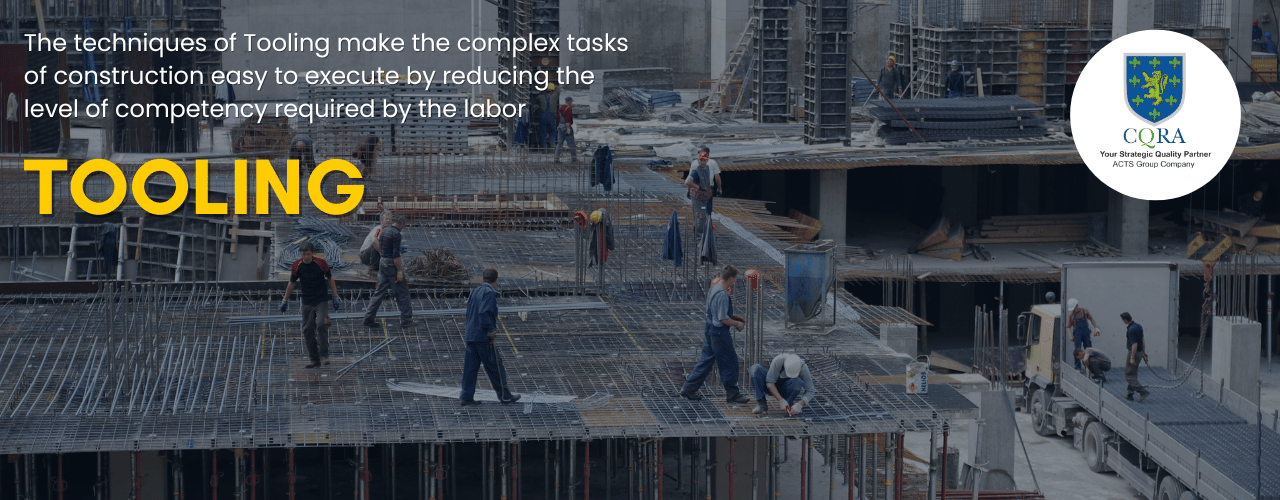If there is a sure-shot way to speed up construction without compromising on quality and to get most out of your semi-skilled labor force, it is this – Tooling.

It’s the small things that make a big difference in built spaces. Who better than construction managers to vouch for this fact. A perfect edge to the wall, tiles laid so well that the floors look like a machine made pattern, water draining perfectly in the bathroom or that smoothly painted accent wall. Good is in the details; however achieving perfection in these details is a matter of skilled workmanship.

The question is how to deliver a build that scores high on quality and pace, all with getting the most out of your workforce, skilled or not?
The answer according to our experts is effective use of techniques and tools that can equip a semi skilled labor-force to perform tasks in relatively less time that a skilled labor often does manually over longer periods. Tooling, as our experts have termed it, is the game-changing concept that can alter the construction scene in India, setting the stage for faster processes while addressing the woes of dealing with a poorly skilled workforce and reducing costs.

WHY IS THERE A DEARTH OF SKILLED LABOR?
Skilled labor is always in great demand at Indian construction sites. Masons, carpenters, tile and stone laying workmen, plumbers, reinforcement workers, painters who can get the job done with a high level of craftsmanship have been crucial to achieving superior finishing to building exteriors and interiors.
The flipside of the scenario here is that learning building skills is not well institutionalized, meaning there are very few avenues like certified courses for people who want to learn the various trades and skills required at the construction site. This knowledge has traditionally been passed on from one generation of skilled labor to the next, or learned on the job and perfected after years of experience. In the present scenario of rapid urban development that calls for fast paced building of infrastructure there is no space for leisurely learning of building skill sets. Also, the workforce in the country is a migrant one, meaning they have not been trained in the art of building and are mostly shifting from one mode of employment to the other.

TOOLING TO THE RESCUE
Though the country has a sizeable workforce, majority of them are semi or unskilled. Tooling is the only solution to harness this valuable human resource that will bridge the skill gap. The techniques of Tooling make the complex tasks of construction easy to execute by reducing the level of competency required by the labor. This is how unskilled workers can perform at sites without affecting project timelines when skilled labor is unavailable, a situation that is increasingly common. So when contractors cannot find expert tiles cutters and layers, reinforcement workers, skilled plaster masons and painters are in short supply, Tooling arms the regular labor with the skill to carry out these tasks.

THIRD PARTY AGENCIES AND TOOLING
Third party Agencies that are involved in setting standard operating procedures for construction companies can use Tooling to solve recurring quality issues on site by reducing dependency on skilled labor and expand management bandwidth. Encouraging engineers to use tools creatively to simplify processes will ensure accuracy and speed at the construction site. The development of mechanized and electrical equipment results in reduction of the costs incurred due to labor or quality issues.

SOME OF THE TOOLS AND TECHNIQUES USED IN THE TOOLING
• Plaster corner beads – To maintain sharp straight edges of plaster corners.
• Use of drain channels in toilets to maintain one-way slope.
• Use of dry walls for faster construction.
• Use of sub frames for windows to ensure accurate sizes of openings so that assembled windows can be installed easily.
• Rebar Wire Tying Machine – to speed up the steel bar binding process.
• Groove Cutting Machine – for even wall chasing in electrical works without impacting the substructure.
• Self Leveling Laser – to help achieve accurate leveling in RCC works
• Electrofusion Welding – to ensure proper jointing in plumbing reducing dependency on skilled plumbers.
• Sanding Machine – to avoid manual sanding that is dependent on the energy of labor
• Paint Spray Machine – to achieve an even finish and in place of using a roller or brush
• Plaster Spray Machine – to get uniform plaster by employing semi skilled labor
• Rebar bending and cutting machines – Rebars are to be cute and bent as per the BBS

OLD MAKES WAY FOR NEW TECH
Bamboo scaffolding and plywood formwork put in place by skilled carpenters is a thing of the past. It has been replaced now by aluminum formwork, a modular system that eliminates errors which even semi skilled labor can erect. Earlier to make concrete on site contractors were dependant on special RCC workers to achieve proper consistency. Now concrete mix design apps and other tools which can be operated by general labor has made concrete-making much simpler.
This goes to show that achieving perfection is not a daunting task anymore for construction managers. With Tooling, technological advances in the form of ingenious tools and technology are the answer to the skilled labor and quality issues of the Indian construction industry.

